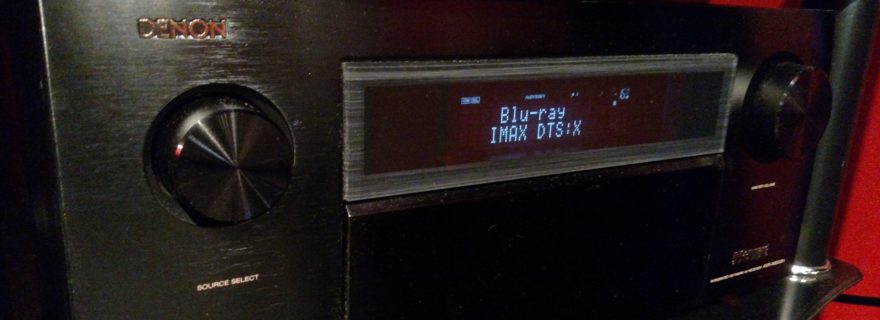As if home theater audio weren’t already confusing enough with the plethora of sound formats available on Blu-ray and Ultra HD, the IMAX Corporation has now introduced another proprietary format, called IMAX Enhanced. What’s unique or special about this one, and should you upgrade your A/V receiver to get it? I’m trying to figure that out.
Between Dolby Atmos and DTS:X (and their little-used competitor, Auro-3D), we home theater junkies already have the ability to fill our rooms with sound from almost any direction. I’m not sure we really need another format right now. (Quite frankly, I’m not sure we really need DTS:X, which lags behind Atmos from both a technical standpoint and studio support.) Nevertheless, IMAX insists on doing its own thing anyway.
IMAX already has a proprietary immersive sound format in its theaters, which consists of 12 channels of sound, 7 of them at the base level and 5 above. Unlike Atmos or (theoretically) DTS:X, the IMAX format is entirely channel-based and does not use 3D sound objects. The home version attempts to mimic this layout, but doing so requires some creative tweaking.
The official IMAX Enhanced press release is pretty vague with details about what exactly the new format really is:
“The IMAX Enhanced program uses the newest, proprietary post-production process developed by IMAX to digitally re-master content to produce more vibrant colors, greater contrast and sharper clarity. IMAX and DTS have also partnered with award-winning Hollywood sound mixers to use a special variant of the DTS:X codec technology integrated in home audio equipment to deliver an IMAX signature sound experience with more immersive, powerful sound.”
The first two movie titles from the IMAX Enhanced program were released this month: the nature documentaries A Beautiful Planet and Journey to the South Pacific. (Both the regular Blu-ray and the Ultra HD Blu-ray discs in the case are authored with the IMAX soundtracks.) At present, only a small handful of A/V receivers are capable of decoding the IMAX Enhanced codec. One of them is the Denon AVR-X8500H flagship model. As far as I know, I’m the only person on this site’s staff to have one of those, so it falls to me to give these discs a spin and see what I can learn about the audio.
11 Channels Maximum
The IMAX Enhanced codec is based on the architecture of the DTS:X format. When the discs are played through a compatible A/V receiver, the front panel display and on-screen menus read “IMAX DTS:X.” If played through a receiver that doesn’t have the new decoder, the audio should fall back to regular DTS:X – or, depending on your equipment, DTS-HD Master Audio or even basic DTS.
Although the IMAX Enhanced format apparently differs from DTS:X in some way (enough to require its own special version of the codec), neither IMAX nor DTS have disclosed those details. What the new format doesn’t do is add support for new discrete speaker locations. IMAX Enhanced is hamstrung by the current DTS:X limit of only 11 channels of audio, which can be configured as either 9.1.2 or 7.1.4. Any X8500H owners (like myself) making use of that receiver’s 7.1.6 channel capability will find their Top Middle speakers silent throughout.
The Magical 12th Channel
That being the case, where does IMAX’s 12th channel, called the Center Height, come from? It’s not a new speaker position, at least not at present. Instead, an IMAX Enhanced soundtrack will virtualize an extra channel by mixing sounds into the other existing channels in such a way that they image between speakers, much as a 2-channel stereo system might create a phantom center effect.
A Beautiful Planet has some of the first examples of this. One occurs near the start of Chapter 2 on the disc. The documentary has quite a lot of voiceover narration, most of it from Jennifer Lawrence, which is mixed as you’d expect from the center channel location in the front of the room. However, at certain points the astronauts in the film will also narrate their thoughts, and in those cases their voices are mixed to come from the front left and right speakers simultaneously with the Surround Back left and right. Their voices do not come from the center, the Surrounds, or any of the heights. In my room, this sounded less like the voices were above me and more like they imaged directly from my seat. It’s a little disconcerting, honestly. I don’t really understand why someone would want to mix the movie this way. If the voices are supposed to sound like they emanate from a voice-of-god position above, shouldn’t they be mixed into the four height channels rather than the ground-level speakers?
This vocal imaging also sounds a little weird in my room because (and I expect this to be a common issue) my Surround Back speakers are not quite on par with my front towers. I think for the effect to work best you’d need to have identical speakers all around.
It’s possible that this may just be one wonky example of an IMAX soundtrack being mixed strangely and that future movies may image sounds less distractingly, but at least for now, I’m uncertain how I feel about it.
I watched Journey to the South Pacific afterwards. Although that one has quite a bit of height channel activity, I didn’t notice any specific Center Height effects like the voices in A Beautiful Planet.
The Big Question
Even taking into account the special sound imaging techniques that an IMAX Enhanced soundtrack employs to create a virtual extra channel, it occurs to me that there’s no reason the same thing couldn’t be done within the regular DTS:X (or Atmos, it should go without saying) format. The effect is all about the way the soundtrack is mixed. As far as I can tell, other than an “IMAX” indicator on the receiver’s front panel, I can’t discern any technical difference between an IMAX Enhanced soundtrack and any other DTS:X soundtrack. That being the case, why does IMAX need its own special codec that you need to upgrade your A/V receiver to decode?
Perhaps something else unusual is going on behind the scenes that isn’t immediately evident from the audible results? But even if so, why bother if the end user can’t tell any difference? Until either IMAX or DTS disclose more details about how this format really works, I’m inclined to feel that it’s mostly a bunch of IMAX marketing hooey.






Judas Cradle
Denon avr-x 4500H and above will have this added via firmware update.
I have no interest in this and seems pointless. And also not thrilled that they also hitched this wagon to HDR10+ discs. (Obviously Panasonic and Samsung had some meetings with IMAX…..)
Josh Zyber
AuthorI’m going to have to do a follow-up post about this. I’ve been doing a lot more testing to figure out just what the IMAX Enhanced mode does, and it turns out that it is doing a considerable amount of manipulation to the audio behind-the-scenes, including boosting the bass and overriding your receiver’s speaker crossover settings.
I’m not sure I like what I’m learning.
Shannon Nutt
Sound is getting to the point that video is – much like 4K reaches the limits of what your eyes can discern (which is why I don’t think 8K is ever going to catch on at home – unless our TVs start taking up the entire wall), these audio formats are going beyond what your ears can discern. I honestly believe that no home theater needs more than 7 channels, but going beyond 11 is kind of crazy unless your home theater is, you know, the size of an actual theater. I finally upgraded to an Atmos home theater this Christmas (and I love it), but can’t imagine that anything “more” would enhance my experience.
But I’m no audiophile, so maybe there’s a market for this.
Scott J
I’ve seen the press releases from DTS and IMAX and I came away still wondering what it does and why it’s necessary. Your article seems to support my initial reaction to peg it as an unnecessary licensing play. As with all such technologies (and in this case, it’s difficult to call this a technology…), it’s got me interested, but the proof is in the application. Maybe additional titles will demonstrate it better.
Codecs are all about support, in hardware and in content. If they can’t get it in at least both Denon and Yamaha upper end units, it’s not going to get traction. If they can’t get A-list movies to use it, it’s not going to get traction. I will admit that they’ve got more titles available now than Auro does!
William Henley
I just cannot believe anyone is adding a fourth format into the mix at this late in the game – especially when you are dealing with a niche audience as it is. As much as I want height, I still haven’t upgraded from 7.1, and most people I know don’t even have surround (although quite a few have soundbars or OLD stereos that they are running their tv through as speakers on televisions are so bad now). I just don’t see how you would recoup your R&D cost this late in the game, especially if you are ridding on top of DTS:X, which few receivers support as it is.
Derek
Sounds like IMAX Enhanced should be referred to as a ‘DSP surround mode’ ala Sony HD DCS or Yamaha Cinema than a surround audio format. Changing speaker crossovers like a dynamic room-correction yikes!
Josh Zyber
AuthorYes, that’s basically the conclusion I’ve come to. I’ll have a follow-up post soon.
jgslima
Maybe they are targeting non-audiophiles, who actually do not understand things like the readers of this site.
Like THX certification. I find funny how many people I know that does not understand about audio formats and codecs, but are delighted when face a THX certified equipment.
But I do not see the IMAX seal with the same force as THX had.
Leon Loi
i have the denon 8500 and sumasung r900 8k 85 ” i have to say the sound is a lot more loud and clear